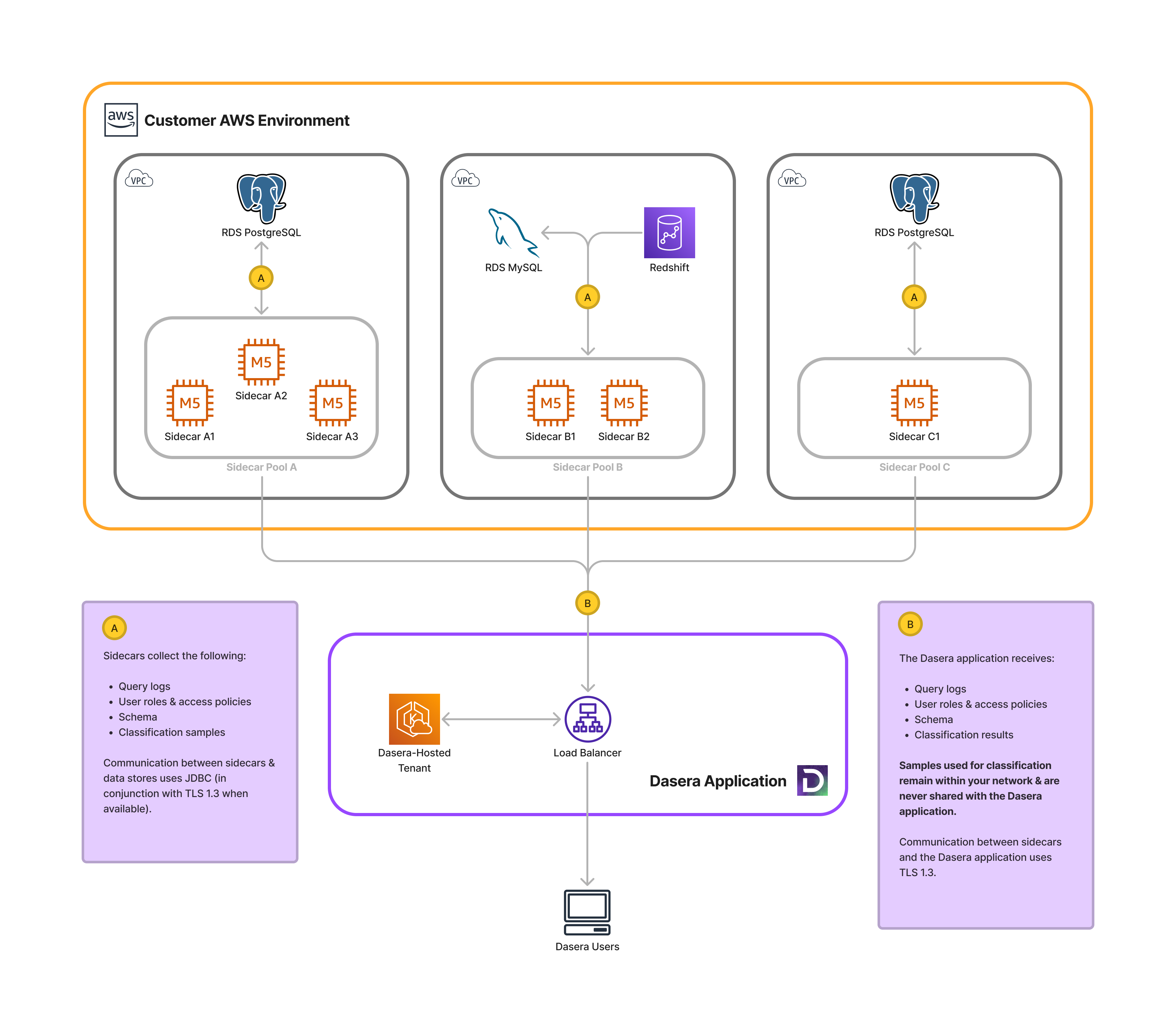Overview
These instructions are used to provision all resources necessary for running sidecars within your own Kubernetes cluster.
Architecture
Excerpt: Sidecar: Architecture
Netskope One DSPM provides a flexible collection architecture, consisting of one or many sidecars you deploy alongside the main application. These sidecars connect to data stores to runs scans, uploading the results to the Netskope One DSPM application.
A single sidecar can scan multiple data stores in its installation environment. Typically, you will deploy one sidecar per individual environment (e.g. VNet, VPC, etc.), however you may choose to install multiple sidecars for additional scalability and redundancy. The Netskope One DSPM application automatically load balances scans across healthy sidecars in each sidecar pool.
Architecture Diagram
Below is an architecture diagram showing the relationship between Netskope One DSPM's resources & environments and your own. While it is AWS-specific, the basic concepts apply to other setups, including self-hosted.

Register Sidecar Pool
Excerpt: Sidecar: Registration
To set up the relationship between your sidecars and Netskope One DSPM-hosted tenant, you will provide the sidecars with a unique authentication token generated within our Sidecar Administration UI.
If you already have an existing sidecar pool token to use, you can skip this section. Otherwise, follow these instructions to acquire a new token.
- Log into the Netskope One DSPM application.
- Navigate to the Platform Settings > Sidecar menu to display the Sidecar Administration screen.
- Click the Add Sidecar Pool button.
- The Add Sidecar Pool modal is displayed.
- On the Details tab, complete the following field:
| Field | Value |
|---|---|
| Name | Any friendly value to describe the sidecar pool. |
- Click Save.
- Click Copy at the bottom of the Sidecar Authentication Token modal to save the generated token to your clipboard.

- Click the “x” button to exit the modal.
Since you haven't yet associated this token with a sidecar, the sidecar pool will appear only when you click the Show Inactive Sidecars icon in the upper right, with empty Version and Status columns for now.
The above-generated token will be used for each individual sidecar within the sidecar pool.
Install Helm Chart
- Download the correct Helm Chart package from the following URL:
wget https://dasera-release.s3.us-west-2.amazonaws.com/helm-dasera-hosted.zip- Extract the package contents.
- Navigate to the extracted dasera directory.
- Run the following command to install Netskope One DSPM, substituting the following parameters:
Note: many deployment parameters can be customized via the command below. We recommend you inspect the contents of the values.yaml file before running this command to familiarize yourself with the deployment parameters and their default values. If you want to change any of the defaults, simply append additional ---set <variable>=<value> flags to the command below.
helm upgrade --install dasera dasera --namespace dasera --create-namespace --set image.tag=latest --values dasera/values.yaml \
--set DaseraMainApplicationHost=... \
--set sidecarPoolToken=... \
--set sidecarCount=...| Parameter | Value |
|---|---|
| Netskope One DSPMMainApplicationHost |
Your tenant URL minus the protocol. For example, if your tenant is accessed using https://example.dasera.io, your value will be example.dasera.io. |
| sidecarPoolToken | An existing sidecar token, or a new one generated in the Register Sidecar Pool section above. |
| sidecarCount (optional) | (optional) The number of sidecars to deploy in conjunction with the application. If left blank, the default will be 1. |
By default, the most-current sidecar image (tagged as latest) will be downloaded to your local repository. If necessary, your account team may advise you to substitute the set image.tag value to a more-specific value; otherwise, use latest.
When the installation is complete, the Helm Chart will display output similar to the following example:
Deployment complete!
Please visit the Sidecar Adminstration page at https://example.dasera.io/platform-settings/sidecar
to confirm the sidecars were successfully registered.Resources Created
Each time it is installed, the Helm Chart will manage deployment & management of the following:
- One or more pod(s) for individual Netskope One DSPM sidecars
You can run the kubectl command to view additional detail on each pod.
Validate Sidecar Connections
Excerpt: Sidecar: Validate Sidecar Connection
When deploying sidecar, you'll need to ensure that the sidecar has the ability to reach two URLs on port 443:
https://[tenant-name].dasera.io https://[tenant-name]-sidecar.dasera.ioTake the following steps to verify the connectivity from the sidecar.
- SSH to the sidecar
- Run the command [curl] to [api/pulse] for both URLs, as shown below
curl https://[tenant-name].dasera.io/api/pulsecurl https://[tenant-name]-sidecar.dasera.io/api/pulse- A successful response will resemble the following
{"version":"10.0.0.311","build_target":"prod","deployment_type":"saas"}%
Once a sidecar is running, you can now validate it is properly communicating with your Netskope One DSPM application.
- Log into the Netskope One DSPM application.
- Navigate to the Platform Settings > Sidecar screen.
- For the sidecar(s) in question, validate that Version column is populated and its matching Status indicator is green.
It may take a few minutes for newly-running sidecars to communicate with the Netskope One DSPM application. If both values have not updated after 20 minutes, double-check that you configured your sidecars correctly and update the pool token, if necessary.
Upgrading Sidecars
You may need to occasionally upgrade your sidecars so they remain compatible with your Netskope One DSPM application instance or tenant.
To upgrade sidecars that were deployed via Helm, you must redeploy the Helm chart using the instructions within the Install Helm Chart section above.
Next Steps
Connect Netskope One DSPM to your infrastructure accounts so Data Store discovery & scanning can begin.